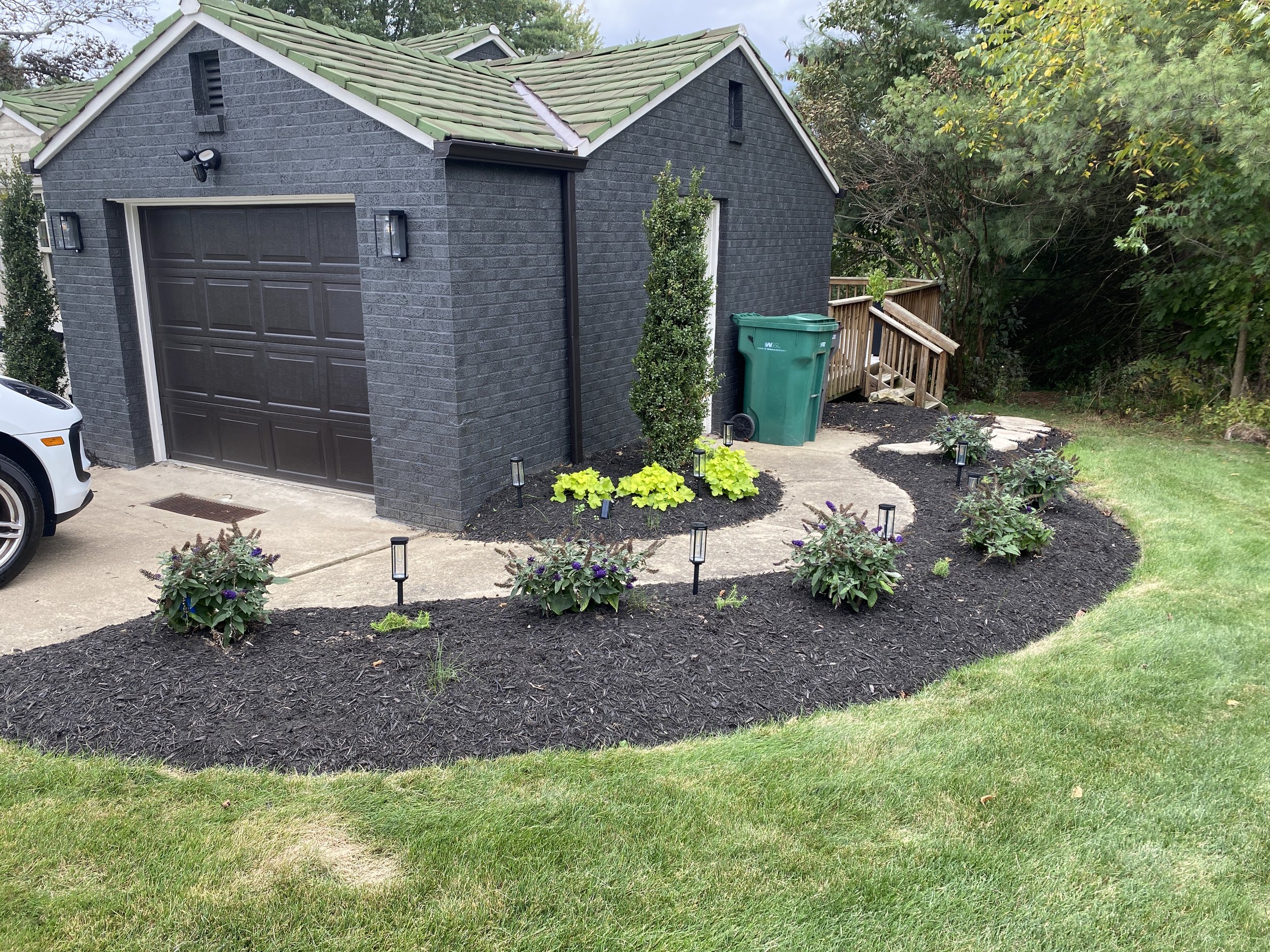DEEP DIVE: FRONT YARD WITH A SIMPLE COLOR PALETTE
Welcome to Deep Dive #1 where I’ll give you a detailed walkthrough of a design I did for a client in Pittsburgh who wanted to keep the color palette simple in their front yard garden refresh.
THE EXISTING SPACE: The garden had become overgrown in the years before my client moved in and she wanted to update the space to be more her style. My client was also getting the house exterior repainted, so I was able to use the renderings from the design firm to help influence color decisions for the plantings. This garden receives full AM sun and full sun for most of the afternoon as well.



THE GOAL: The client wanted to simplify the existing garden beds and create a cohesive look for the entire garden. They preferred clean lines & mass plantings and also had a specific color palette that they liked: purple & white blooms and chartreuse (yellow-green) foliage. She sent me inspirational photos so I had a clear vision of what she wanted both color-wise and design-wise. The clean lines were not to be overly formal, and she didn’t want it to feel cottage-y. This area was not heavily used by deer, but we erred on the side of caution and planned to use mostly used deer-resistant plants.
THE DESIGN:
The first step was figuring out the new garden bed layout. The existing beds were overcrowded and too deep in some areas, so we reduced the size of some of the beds and added new, shallow beds along the main pathways. These 3ft deep beds provide clean lines and are also a good size to flank 3ft wide walkways. Shallow beds also allow us to keep maintenance in mind - they are accessible from all sides for easy weeding, mulching, and pruning.
Next, we worked on the plant palette. The client made it easy and narrowed down the choices to mainly purples, white, and chartreuse. The goal for any of my planting designs (unless otherwise requested) is to have a succession of blooms throughout the growing season and to create a garden that is beautiful even when things aren’t in bloom. To achieve that, I made sure we had spring, summer, and fall bloomers. The main bloomers used are Creeping Phlox & Salvia for spring color, Hydrangea for summer color, and Butterfly Bush & Caryopteris for late summer color. We placed the chartreuse foliage of the ‘Beekeeper’ Caryopteris next to the true-green of the Boxwoods allowing for a contrast in foliage color that doesn’t rely on blooms to be visually interesting. We also included a few pockets of chartreuse and deep purple Heuchera for another foliage contrast moment. Boxwoods of various shapes & sizes were included for evergreen interest and to tie each garden bed together.
The plant placement was crucial here because we were trying to create balance in front of an asymmetrical home. The house is only 1-story so we didn’t want to include anything that would overwhelm the home. We included some “exclamation points” near the house in the form of taller ‘Dee Runk’' Boxwoods that would bring vertical interest without drawing too much attention away from the facade of the house. We also worked on horizontal balance by extending the beds along the long front pathway away from the house. This allowed for a reduction of lawn along the front pathway, which felt like a better lawn-to-bed ratio compared to the previous bed sizes. As a bonus, the beds along the front pathway really draw your eye to the front porch and lead you to the home.
The last major design note was plant layering. The 11ft deep beds at the foundation of the house were easy to create layering because the depth was there. We had the space to include a row of low Veronica groundcover in front of a row of medium-sized Boxwoods in front of taller Hydrangea. However, the 3ft deep beds along the paths needed a different approach to layering. We decided to go with alternating plantings. In-between each Boxwood was either Salvia (spring blooms) or the Caryopteris (summer/fall blooms). I was happy the client was on board with this idea because it allowed this part of the garden to have varying interest throughout the entire year, as opposed to just doing a simple, one-note Boxwood hedge.
Below are images of the rendering used for the design (a key part of my Full Design process so the client can easily visualize what the garden will look like) and the final Planting Plan.



THE RESULT: I am so pleased with how this garden turned out! You can clearly see the refined color palette, the formal-yet-fun use of Boxwoods intermixed with blooming plants, and the house feels a lot more inviting to walk up to. The pollinators love it as well! The client used a local landscaping company to remove the existing plantings, create the new beds, and install the new plantings.





If you are in the Pittsburgh area and need help designing your garden, please check out our garden design consultations!






